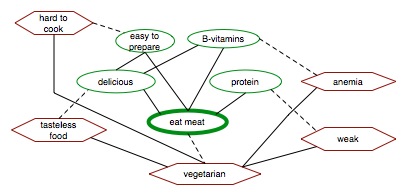PHIL 224, Assignment 3, Value Map 3
THE DEADLINE FOR ASSIGNMENT 3 IS EXTENDED UNTIL TUESDAY, NOV. 29 BECAUSE OF INTERMITTENT EMPATHICA PROBLEMS CAUSED BY HIGH LEVELS OF USAGE.
CONSIDER DRAWING MAPS USING ANOTHER PROGRAM SUCH AS MICROSOFT WORD OR BY HAND.
Introduction
This assignment is due Thursday, Nov. 24, 11:30 a.m., in class. It is worth 9 marks out of 100 for the course.
Late assignments will be accepted until Nov. 29 at 11:30, in class, but will receive a maximum of 7 marks.
After Nov. 29 at 11:30, assignments will not be accepted, except for documented reasons of illlness or family emergency.
Instructions
Students will analyze an important issue in environmental ethics using value maps, a kind of cognitive-affective map.
Choose ONE of the two topics below.
Hand in a single page, two-sided, consisting of:
- Your last name, first name, student number.
- Title: topic question.
- Value map of the yes view.
- Value map of the no view.
- Discussion, 150-200 words, of the similarities and differences between the yes and no views. Provide a word count.
- Conclusion, 50-100 words, on why you think the yes map or the no map is ethically superior
Topics
1. Is hydraulic fracturing (fracking) a morally right way to increase energy production? Yes or no.
2. Are wind farms a morally right way to produce energy? Yes or no.
Drawing Value Maps
Instructions for drawing cognitive-affective maps is available here.
Each map (maximum 1/2 page) must include:
- A node for the topic, e.g FRACKING, WIND FARMS. . This will be positive in the yes map and negative in the no map.
- At least 5 positive concepts, represented by ovals.
- At least 5 negative concepts, represented by hexagons.
- Marker of *C* for consequences or *R* for rights for all positive and negative concepts.
- At least 3 positive links between concepts, represented by straight lines.
- At least 2 negative links between concepts, represented by dotted lines.
- Green circles and red hexagons, if you use colour (optional).
- Support for a positive concept (oval) by complimenting it (solid line) with other positive elements.
- Support for a positive concept (oval) by having it conflict (dotted line) with negative concept (hexagon).
- Counter-support against negative elements (hexagon) by solid lines to other negative elements or dotted lines to positive elements.
Tools for drawing value maps.
- EMPATHICA (requires a gmail account) will be the easiest for many students. Known bugs: does not work with some laptops. Avoid the SAVE button; just use the DONE button.
- Any computer drawing program, e.g. Microsoft Office, OpenOffice, OmniGraffle, Illustrator, etc.
- Hand drawing - a stencil will help.
DO NOT:
- Confuse emotionally positive and negative concepts, or complimentary and conflicting links.
- Have the same node both positive and negative.
- Have nodes that are completely unconnected to other nodes.
- Have connections that don't make sense, e.g. having LOVE OF ANIMALS linked supportively with ANIMAL SUFFERING.
- Present both the pro and con side in the same map.
Example
1. Pro-vegetarian value map

2. Anti-vegetarian value map

Marking
Each value map will be worth 3 marks.
The discussion will be worth 2 marks, and the conclusion 1 mark.
Paul
Thagard
Computational Epistemology
Laboratory.
This page updated Nov. 23, 2011


